When we think of a seasonal discount, our thoughts usually jump straight to Black Friday or other times of the year where we see seasonal sales. It’s certainly no secret that these holidays bring retailers a substantial amount of their annual revenue.
However, seasonal discounts can accomplish far more than just boosting sales. It can also help to drive brand awareness, foster customer loyalty, and build a healthier cash flow for slack periods of consumer demand.
For this reason, it’s important to understand how to maximize the benefits of seasonal price reductions for your business and how to avoid their drawbacks.
Let’s dive in.
What is a seasonal discount?
A seasonal discount refers to special offers that are tied to key events or holidays. These are used by retailers to drive sales with the overall goal of increasing traffic and revenue.
Seasonal discounts are used by a wide variety of businesses, including big box retailers,department stores, and local high-street stores, though their discounting methods and celebrated seasons will vary.
Why seasonal discounts should be part of your ecommerce strategy
Many retailers leverage seasonal discounts for a number of reasons, including:
Leveraging periods of peak spending
Even with the disruption caused by COVID-19, the upcoming holiday season is still going to be a key seasonal event. According to Visa’s 2020 Back to Business study, 76% of small to medium-sized businesses see the festive season as a major sales opportunity.
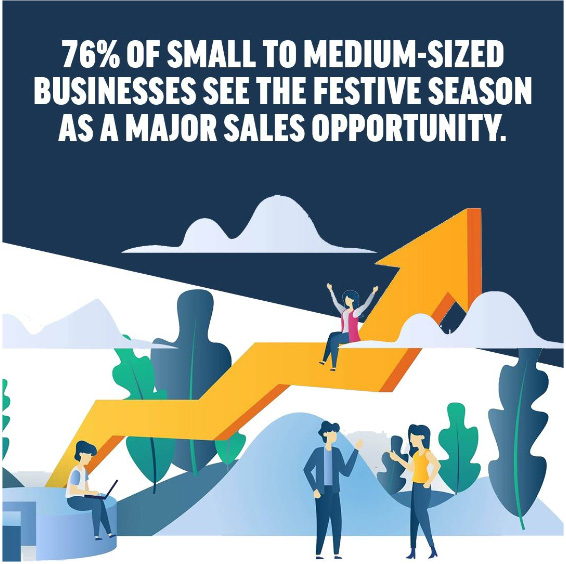
For example, it’s common knowledge that consumers are chasing steep discounts on normally full-price products during Black Friday and Cyber Monday. By contrast, Small Business Saturday is focused on supporting local retailers, where consumers are often willing to spend more.
Targeting different consumer priorities in this way enables your business to better capitalize on seasonal opportunities.
Promote new seasonal product lines
Seasonal promotions are also commonly leveraged to drive sales for new or “in season”products. These types of offers don’t usually come in the form of seasonal discounts; instead,brands use a “first look” or “first to know” type of promotion to market and sell new seasonal items.
Clearing last season’s inventory
You can also use seasonal sales as an opportunity to clear out last season’s merchandise. By having a discount on these slow-movers or using them as freebies or gifts, you could drive sales while making room for fresh and in-season merch in the process.
Engage customers over the short- and long-term
Seasonal holidays and events provoke a range of emotions — excitement, joy, celebration, and yes, sometimes stress and anxiety. As a retailer, empathizing with your customer is the key to attracting shoppers in a very crowded marketplace.
Discounting techniques, especially when paired with compelling seasonal messaging, allows your brand to better resonate with the mood of your customer base.
It’s also important to note that these discounts can drive sales and engagement long after the season is over. Seasonal discounts can reel shoppers in, but they also pave the way for continuous engagement over the long term
When implemented correctly, discounts can drive future purchases. Research by Optimove found that the likelihood of developing brand loyalty and getting subsequent orders from newly acquired customers “is significantly higher when the discount claimed on the first offer is between 5% and 20%.”
How to implement seasonal discounts
Now that we’ve covered the basics of seasonal discounts, let’s look at the best practices to implement when running these promotions.
Know what holidays,seasons, and periodic events are best suited to your business
Fact: not all holidays are alike. While some occur on a fixed day each year (such as Fourth of July, Halloween, or Labor Day), others revolve around annual seasonal events (such as the back-to-school season where student discounts are eagerly sought after).
As a business, it’s important to know which holidays are worth tailoring seasonal discounts for and which are not.
For example, Valentine’s Day is easily going to be one of your biggest sales opportunities if you’re a florist or jeweler — but not so much for a sporting goods store. Similarly, anyone selling confectionery is going to do well during Easter or Halloween, but their sales may be relatively slower during Cyber Monday.
You should also be mindful of public events in the realm of sports (Olympics, World Cup),politics (elections), or pop culture (blockbuster movies, entertainer tours). These events can influence your sales and discounting strategy.
For instance, if you’re a casual apparel retailer and sell team shirts, you could run a seasonal promotion or discount on those select items.
To effectively keep track of all relevant holidays and events, be sure to create a seasonal discount calendar based on your industry.
Think about which seasonal discounts are appropriate
While discounts help to drive interest in your offerings, they can reap lackluster results if you don’t have the right products on sale or don’t come up with a relevant (e.g., seasonal) hook.
For example, store wide percentage discounts are easy to implement and result in high conversions, but they may not have as big of an impact as seasonal offers. Why? Because they aren’t targeted at consumers’ seasonal purchasing decisions.
It’s for this reason that we see deals on grills or outdoor furniture in stores like Lowe’s or Home Depot in the lead-up to Memorial Day. This holiday is seen as the start of summer, and so is a great time to prime consumers for summer retail spending — especially when there are personal finance options available.
By selecting seasonal items that are likely to perform well, you can boost your revenue without devaluing the rest of your offerings.
Pro tip: Use off peak times to test which discounts work the best. Do your customers prefer percentage discounts or free shipping? The best way to find out is to test these offers during slower periods, then implement the winning offers when peak season rolls along.
For best results, use a promotions analytics solution to get the right data. Thrive, for instance,offers capabilities that enable you to test and analyze your discounts and offers to determine the best ones.
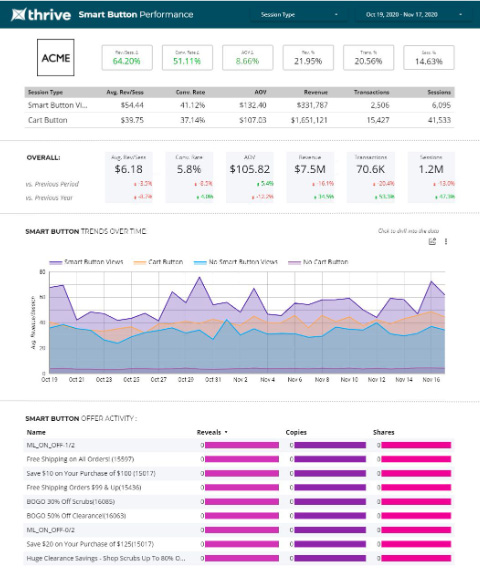
Focus on driving customer retention
Seasonal discounts are often viewed as an opportunity to drive sales and spread brand awareness, not necessarily as a time for building customer loyalty. But when the probability of selling to an existing customer is 60-70%, compared with 20% for new customers, you simply can’t afford to neglect such an important segment. At the end of the day, you won’t just want consumers to buy from you once; you want them to shop with you again and again. By using seasonal discounts that incentivize repeat purchases, you are putting your business in a much more favorable position to grow and thrive in the long term. You could, for example, offer a seasonal discount on the customer’s first purchase, then encourage them to spend more later on. Another approach would be to use their seasonal purchase history to make product recommendations going forward.
Pro tip: Use discounts to collect customer data and build your CRM. At Thrive, we let you gate your discounts through “Data Required Promotions”, a feature that requires customers to enter their details (e.g., email, mobile number, birthday, etc.) before they can redeem the offer.
Make sure you market it
Make it a point to build buzz around your seasonal offerings. Have a robust marketing strategy in place to ensure that your customers are in the know. Think:dedicated offer page, banners on your website, email blasts, and regular social media reminders — the more effort you put in, the more likely you are to see a big boost in sales.
Seasonal discount examples
Looking for seasonal discount ideas? Here are a few examples to consider.
Tiered discounting
A tiered seasonal discount is an excellent way to reward members of your loyalty program for their patronage — and to entice new customers to join to receive great rewards. Sephora has long been a master of the tiered loyalty discounting. The company keeps its deals simple and easy for consumers to understand through engaging social media graphics, like this one from its recent Holiday Savings event:

It clearly communicates that Sephora’s Rouge members don’t just get a higher discount; they also get their first pick of the merchandise. It makes it both a strong seasonal promotion and a clever marketing campaign for their Beauty Insiders program.
Flash sales
If you’re looking to drive a sense of urgency and excitement, offering seasonal discounts via a flash sale is a great strategy. A flash sale is where brands offer discounts or promotions for a limited period of time to entice customers to shop immediately.
Flash sales are particularly valuable when you have excess inventory that you want to off load quickly, such as end-of-season stock from the summer or winter.
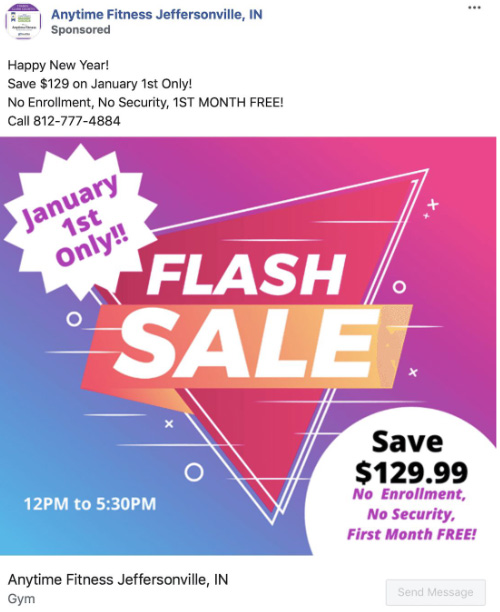
Consider this example from Anytime Fitness, which offered a special seasonal deal for new members on the 1st January to celebrate the New Year — just as people typically start making fitness resolutions.
Conditional promotions
A conditional promotion puts an incentive in front of your customers to persuade them to spend more, thus increasing the size of your average transaction.
Conditional promotions are a popular form of discount pricing because they’re so versatile. They work for things like discounts (e.g., “spend X and get X% off”) and they also do well for things like free shipping (e.g. “free shipping on all orders over $100).
The skincare brand Paula’s Choice leverages conditional promotions quite well, and often runs several conditional promotions simultaneously, even allowing customers to redeem multiple offers.
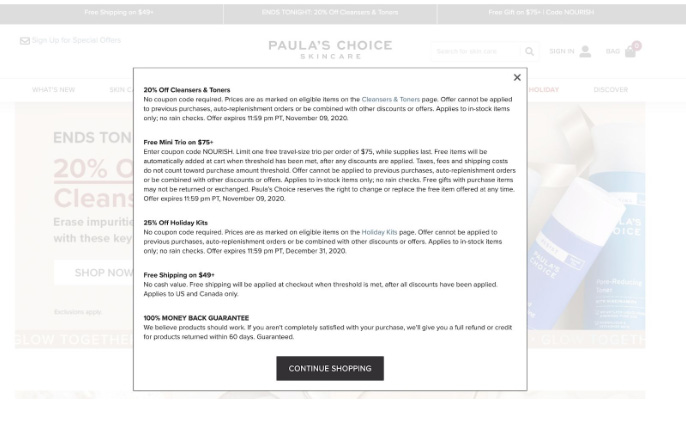
Early Access
Early access sales are exactly what they sound like: these are promotions that give select people a chance to redeem offers and shop the sales before they officially kick off.
Kipling, a retailer that sells bags and accessories, did just that for its Black Friday promotion.Kipling used Thrive’s Data Required Promotions to collect shoppers’ email addresses. Those customers were then given access to a pre-sale prior to Black Friday, and helped Kipling grow its database.
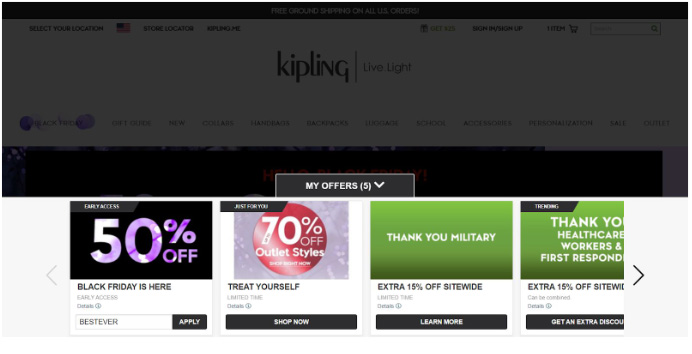
The bottom line
Seasonal discounts are a powerful strategy for retailers, especially as we get closer to the holiday season.
These offers not only provide an immediate revenue boost, but they also allow you to strengthen your ARM — acquisition, retention, and monetization.
That’s why it’s important to be strategic with your seasonal discount offerings. Find ways to engage shoppers in the moment, but don’t forget to think long-term. Remember, when implemented properly, seasonal discounts and benefit your brand even after the season is over.
Good luck, and happy holidays!

